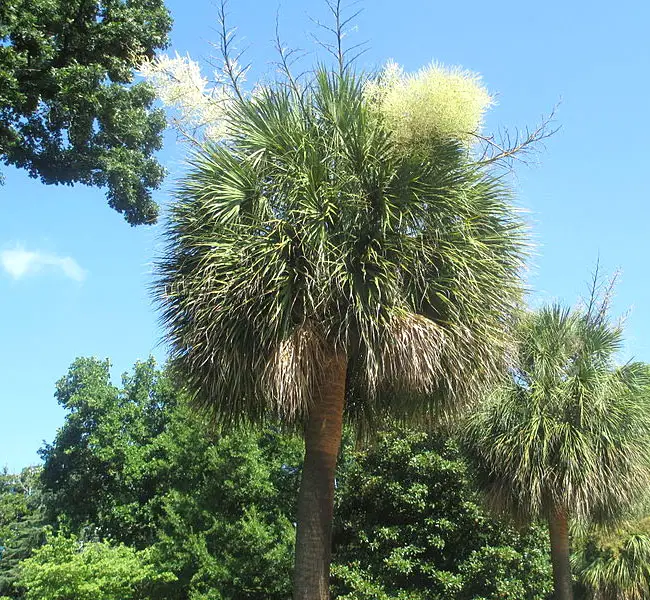
South Carolina has a lot of warm areas that are ideal for growing palm trees. Its humid subtropical climate, characterized by hot summers and mild winters, provides ample sunshine and warmth for a wide variety of palm species to flourish.
Average July temperatures in South Carolina typically range from 89 to 92°F (31-33°C), while January brings milder temperatures ranging from 50 to 59°F (10-15°C). The state experiences tropical cyclones and thunderstorms during the summer months, while winter brings an average of about 1 inch (2.5 cm) of snowfall.
With approximately 64 days of thunderstorms each year, South Carolina also faces the threat of tornadoes. The state’s climate has witnessed extremes, with the highest recorded temperature reaching 111°F (44°C) and the lowest dropping to -20°F (-29°C).
South Carolina’s USDA hardiness zones encompass a range from 7a to 9a, making it easy to find cold-hardy palm varieties suitable for Zones 8 and 9. While growing palms outdoors in Zone 7 requires significant acclimation and cold protection, it is feasible.
South Carolina USDA Zones
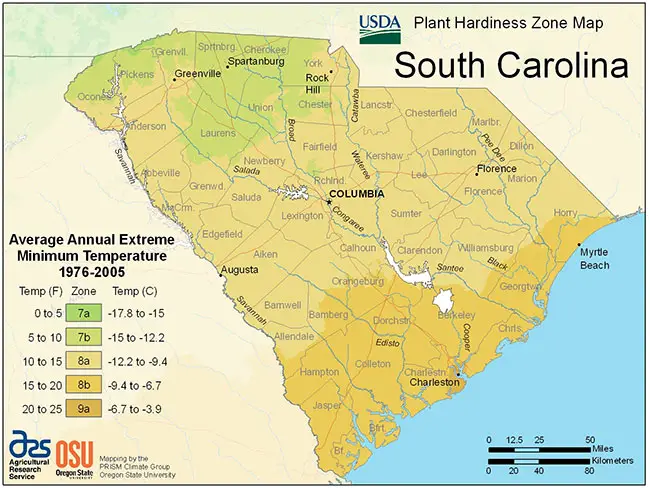
10 Palm Trees That Grow in South Carolina
Living in USDA hardiness zones 8 or 9 in South Carolina provides an excellent opportunity to successfully cultivate cold-hardy palm trees. There’s a wide selection of palm species suitable for these zones. Here are some palm varieties that thrive in South Carolina’s Zone 8 and 9 climates:
1. California Fan Palm (Washingtonia filifera)
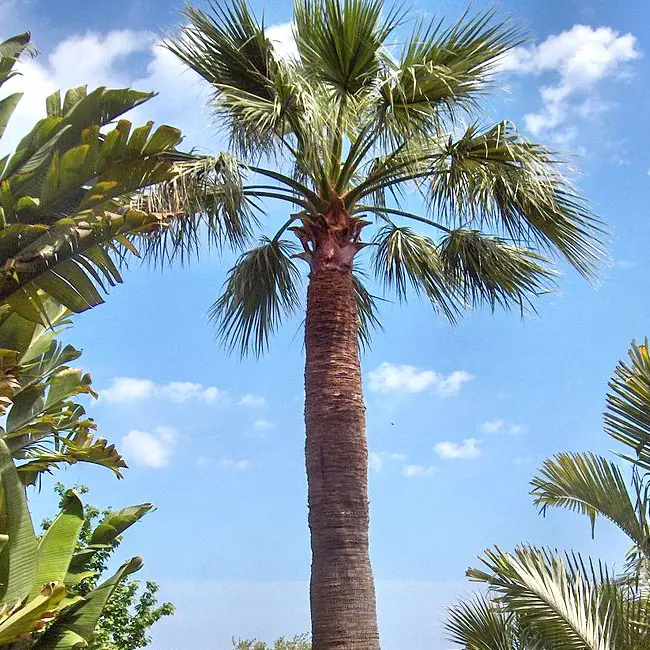
One such palm suitable for South Carolina is the California Fan Palm, scientifically named Washingtonia filifera.
Native to the American southwest, including California and Arizona, this palm may not grow as fast or as tall as the Mexican Fan Palm, but it boasts a mature appearance characterized by a robust trunk covered with old leaf bases.
Its fan-shaped yellow-green leaves feature distinctive droopy tips. Drought-tolerant and well-suited to dry climates, it can endure cold temperatures down to 10°F and thrives in South Carolina within Zones 8a to 9a.
2. Dwarf Palmetto Palm (Sabal minor)
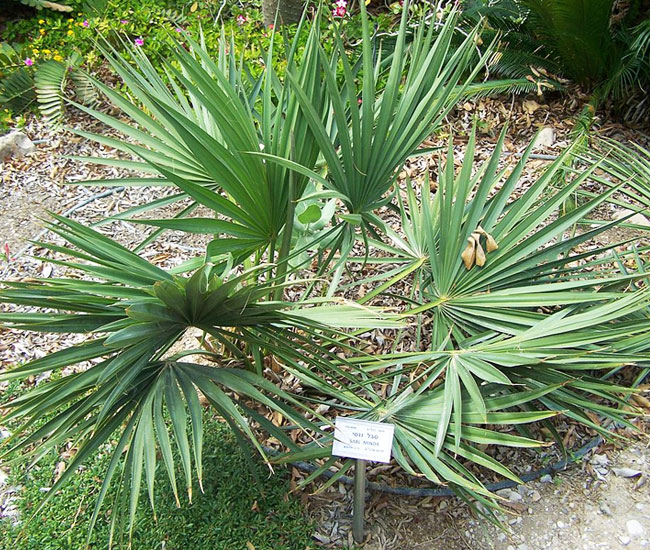
Another excellent choice is the Dwarf Palmetto Palm, scientifically known as Sabal minor, which is native to the southeastern United States, including South Carolina.
Unlike the invasive Saw Palmetto Palm, this clumping plant has a short trunk or one that is below ground level. It lacks spines on the sides of its stems and forms non-invasive colonies.
Its fan-shaped fronds exhibit a range of colors, from green to bluish-gray, with pronounced splits forming a ‘V’ in the middle of each leaf.
Remarkably cold-hardy, it can withstand temperatures as low as 20°F and is known to survive exposure to even -5°F and -10°F without cold protection. This palm thrives in all areas of South Carolina and is best planted from a container due to its challenging transplanting process.
3. Jelly Palm Tree (Butia capitata)
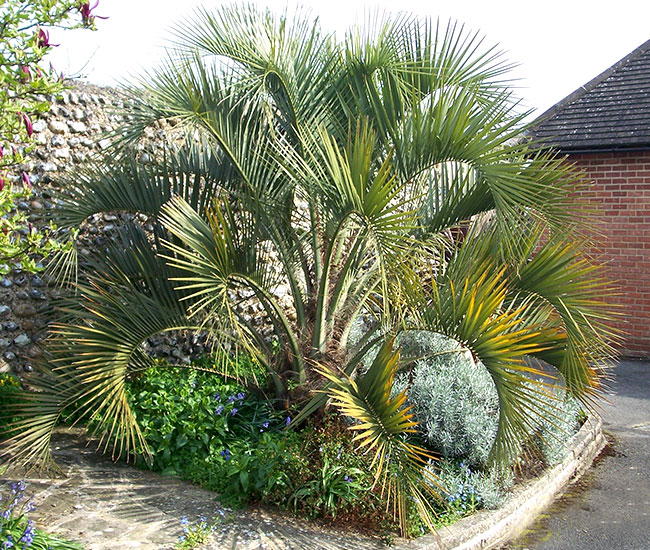
The Pindo Palm Tree, scientifically known as Butia capitata or Butia odorata, stands as one of the most cold-hardy palm species, boasting feather-shaped leaves. Originating from Brazil, Uruguay, and Argentina, this palm is a common sight in the Southeast, including South Carolina.
This medium-sized palm showcases gracefully arching fronds in shades of grayish-green to bluish-green, complemented by a short, grayish trunk. While not as cold-tolerant as the Palmetto Palm, it can withstand temperatures down to 15°F.
However, temperatures lower than 15°F may result in leaf damage. In South Carolina, it thrives best within Zones 8a to 9a, requiring full sun and well-draining soil.
4. Mediterranean or European Fan Palm (Chamaerops humilis)
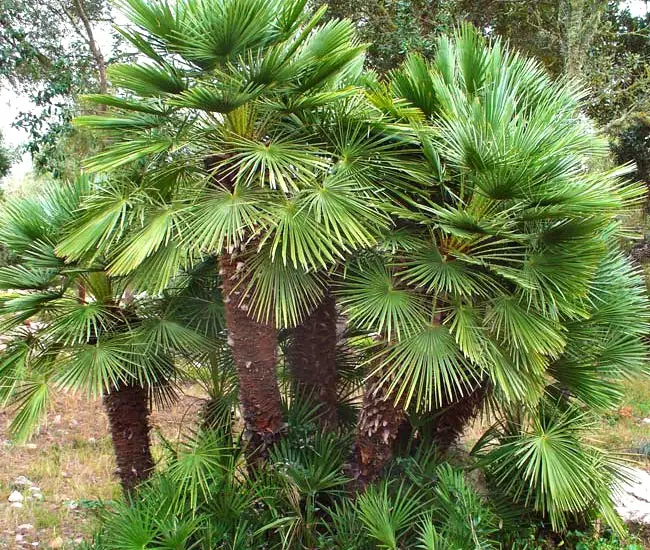
The European Fan Palm, scientifically named Chamaerops humilis, is a robust fan palm native to the Mediterranean region of Europe. In its wild habitat, it thrives in mountainous areas with poor, rocky soils.
This slow-growing palm forms a sizable clump with stiff leaves and a skirt of dead leaves beneath the crown. In South Carolina, it typically reaches heights of no more than 5 feet.
This resilient plant exhibits impressive cold hardiness, tolerating temperatures down to 5°F without any damage. In its natural environment, it has even been known to endure snow cover.
Furthermore, it exhibits exceptional drought tolerance when mature. South Carolina gardeners can successfully cultivate the Mediterranean palm in Zones 8a to 9a, although Zone 7b may present challenges without winter protection.
5. Mexican Fan Palm (Washingtonia robusta)
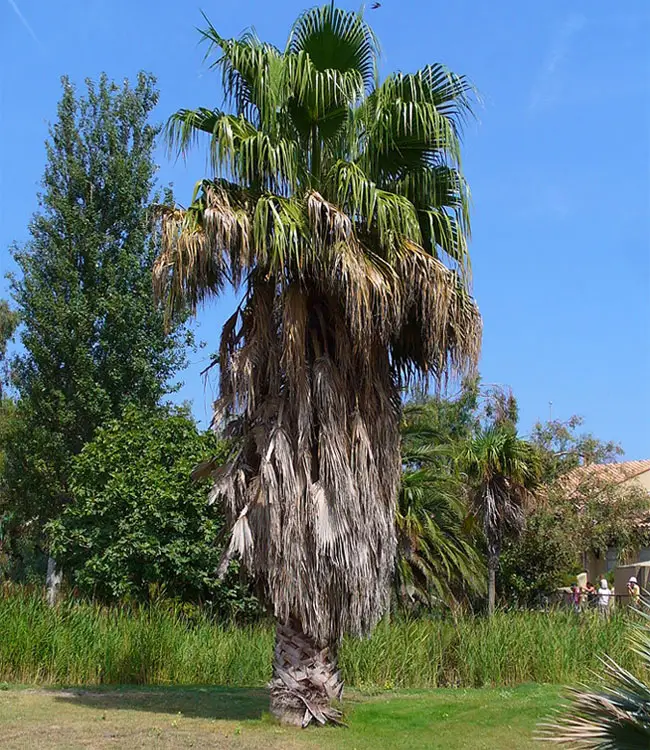
the Mexican Fan Palm, scientifically named Washingtonia robusta, hails from Mexico. In its early stages, it is often mistaken for the California Fan Palm due to similar growth habits and preferences for well-drained acidic or alkaline soil.
This fast-growing palm can withstand cold temperatures down to 10°F, but temperatures lower than 23°F may lead to leaf damage.
South Carolina gardeners can thrive with Mexican Fan Palms in Zones 8b to 9a. For those willing to accept annual defoliation, Zone 8a is also a viable option.
6. Needle Palm (Rhapidophyllum hystrix)
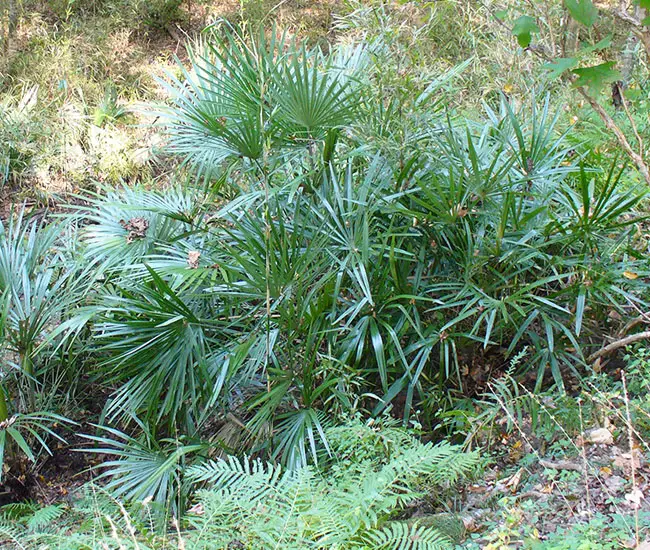
The Needle Palm Tree, scientifically known as Rhapidophyllum hystrix or Rhapidophylum hystrix, is a unique native of South Carolina. Unlike Windmill and Palmetto Palms, it grows as dense shrubs and lacks an obvious trunk.
This adaptable palm holds the title of the world’s hardiest palm, with the ability to tolerate temperatures as low as 10°F and even survive at -5°F. Officially, it is listed as cold-hardy for USDA Zones 8a (with temperatures of 10 to 15°F) to 10b (above 35°F).
To endure these low temperatures, the Needle Palm must reach maturity. Once established, it can be grown throughout all areas of South Carolina without requiring protection. However, it is advisable to provide some cold protection during the first year or two after planting it in the ground.
7. Palmetto Palm (Sabal palmetto)
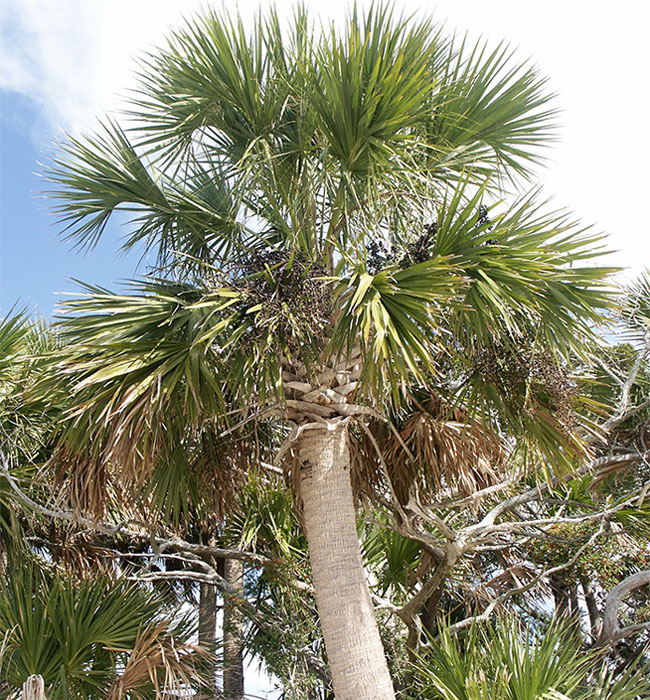
Sabal Palmetto, the state tree of both South Carolina and Florida, stands as one of the most common native palms in the United States. Also known as the Cabbage palm, Sabal palmetto thrives in the wild along the South Carolina coast and can even be found near the state capital in Columbia.
Characterized by its massive trunk adorned with old leaf bases in a crisscross pattern and a sprawling canopy featuring blue-green fan-shaped leaves, this slow-growing palm exhibits impressive resilience.
It can endure both drought conditions and cold temperatures down to 10°F when it reaches maturity. In South Carolina, it can be successfully grown from Zone 8b to 9a without requiring any protection. However, in Zone 7b, especially when young, it is advisable to shield it from the cold during the winter months.
8. Sago Palm (Cycas revoluta)
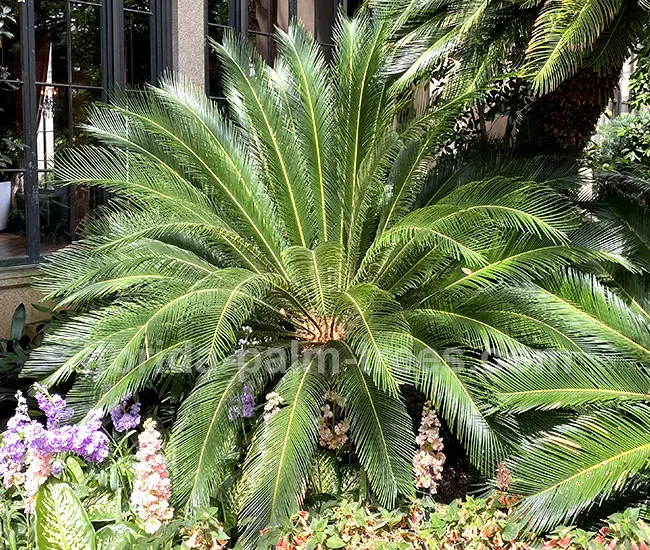
Though not a true palm but rather a cycad, the Sago Palm, scientifically known as Cycas revoluta, is considered one of the oldest unchanged plants on Earth, dating back millions of years.
Originating from Japan, this evergreen features a brownish-black trunk crowned with stiff, palm-like fronds. Sago palms thrive in well-drained sandy soil with a preference for either acidic or alkaline conditions.
They adapt well to full sun but can also grow in shade. Drought-tolerant, Sago palms can withstand temperatures as low as 20°F, though leaf damage may occur if temperatures drop below 15°F. In South Carolina, they flourish best in Zone 9a.
9. Saw Palmetto Palm (Serenoa repens)
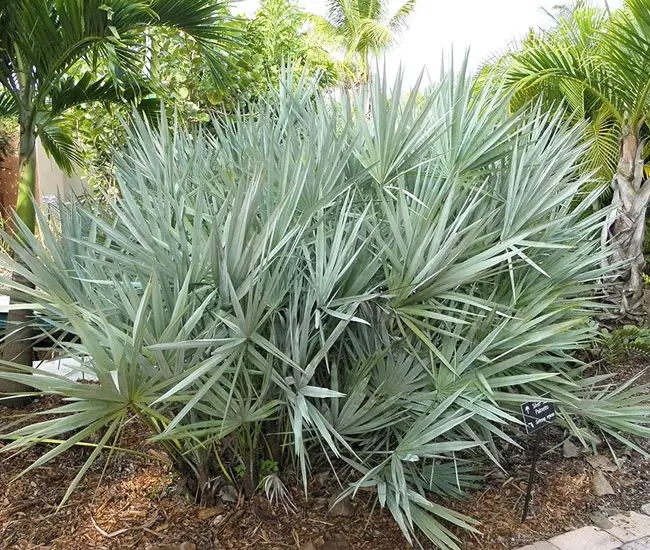
Saw Palmettos, scientifically known as Serenoa repens, are native to coastal regions of the Southeast, including South Carolina. These dense, weedy plants create distinctive ground cover in dry forest areas.
They sport fan-shaped, stiff fronds with a creeping trunk that travels along the ground’s surface or through the soil. Although visually resembling the dwarf palmetto, saw palmettos are rarely found growing together in the wild.
Due to the difficulty of transplanting, it’s advisable to obtain a container-grown plant. These slow-growing palms can tolerate cold down to 10°F.
While they can be grown throughout all areas of South Carolina, Zone 7b necessitates some cold protection, particularly for younger plants.
10. Windmill Palm (Trachycarpus fortunei)
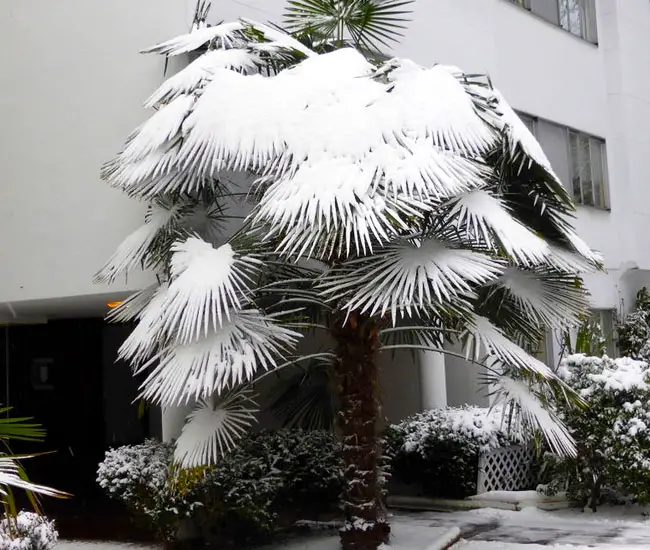
The Windmill Palm, scientifically named Trachycarpus fortunei and native to China, features a dense canopy of dark green fan-shaped leaves and an 8-inch-thick trunk covered with brown fibers and old leaf bases.
This highly durable palm can endure cold temperatures down to 22°F and has even been known to survive at -10°F. In extremely cold conditions, it may fully defoliate but will bounce back in the following spring.
In its native habitat, it occasionally experiences light winter snowfall. While you can cultivate the Windmill Palm in South Carolina from Zone 7b to 9a, it thrives best in warm temperate climates with cool summers, similar to California.
If planted in a hot tropical climate, it may not flourish and could have a shorter lifespan. Therefore, when planting in the southeastern region of South Carolina, it’s advisable to provide the palm with light to medium shade.
Related articles:
–Palm Tree Cold Hardiness USDA Zone Map
–10 Expert Tips On Growing Palm Trees In Cold Climates
–Top 20 Palm Trees That Can Survive Freezing Weather
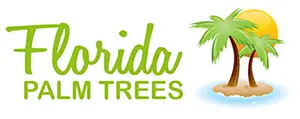
Building a house in Hilton Head. Need tall palm trees that can survive the re-planting,
I would like to get some pricing on some Palmetto trees near Lake Murray and installation. Thank you, Jeremy go away
This was very helpful in our decisions for palms at our new home.
Will a sylvester palms grow and survive in Conway SC.
We have been told two different stories
Thank you for your help.
Lucia
Please contact me asap. Need expert look see at 4 Florida palms I bought for lots of money. Not doing well.
Will Royal Palms grow in Hilton Head SC?
I live in Myrtle Beach SC can a ponytail palm survive outside. I guess we are in zone 8.
I believe the name is a traveling palm. Will that survive in Greenville SC?
I live in Murrells Inlet SC. I was told you should only plant Salbal palms in the spring or summer. I’m having patio work done in November and would like to Hs e the palm trees planted now.
What do you think?